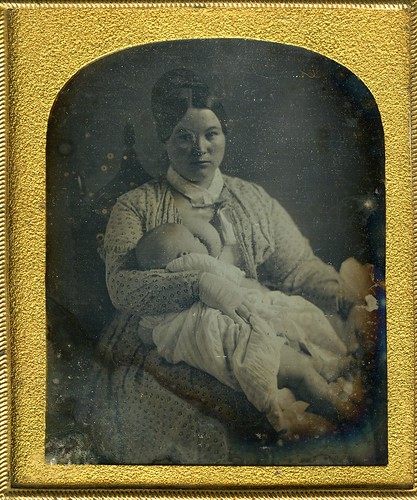I was goofing around on Flickr earlier this evening and came across three Daguerreotype photographs from the mid-1850s (probably, judging by the hairstyles and dresses) of women breastfeeding their babies. I thought that these three photos were quite beautiful as a tender moment was committed to a sheet of tin with the top technology of the day.

This sweet-faced woman seems to have been doing a stellar job at feeding her child. You’d go a long way to find a more bonny baby that that one. I am also finding this photograph interesting from a fashion history standpoint. I notice that the collar and ribbon are separate from the bodice of her dress and were left fastened.

This aristocratic-looking woman holds a burp cloth at the ready as her baby enthusiastically feeds. You can see that he or she was batting his or her right hand as the picture was taken. Post-processing the photographer daubed bits of gold leaf on to highlight the woman’s ring and earrings. You can see how the structure of her garments dictates her figure to an extent. The corset stops directly below the breasts, making them seem especially prominent. Once again, the woman’s collar remains fastened separate from the dress bodice. I knew these collars were separate from the dress, but I’d always assumed they were attached via pins or buttons. I didn’t realise that they were just tied around the base of the neck like a choker necklace.

The last photograph of the three is of a woman nursing a toddler. Some odd manipulation has been done to the Daguerreotype which resulted in loss of detail in the child’s dress and half of the woman’s collar. I’m guessing that it had been prepared for hand tinting and that the pigments once used to highlight the image have somehow been lost.
These photographs are the property of Harvard University, part of their women’s history resources. I am curious about these photos. I wonder why they were taken. This is not a common or typical genre of mother-and-child photographic portraiture from the era. They’re all roughly contemporary. Judging by the women’s clothing, they were probably taken within a year of each other, at most. The last woman has a fairly unfashionable hairstyle, but her dress is up-to-date for the mid-1850s. The dropped shoulder line, front-fastening, gathered or pleated front bodice, the tucked trim on the sleeves, and the very full skirts supported only by petticoats are quite typical of the time.
Because I was curious to the brim, I went ahead and used their “ask-a-librarian” form to see if anyone could provide provenance or context for these images. I will share, if I get a response.
It’s funny, but I have never thought of breastfeeding in context of beauty. I have long considered it practical and also very sweet, as it’s built in snuggle time. The level of contentment that radiates from a nursing baby is also hard to top. When you’re living with a very small infant who cannot express any nuances of feeling and is either content or distressed, that contentment is what you strive for and treasure.
Myself, when I’m breastfeeding, I’m all sweaty and sometimes leaking and generally feel like a hot sticky mess. Maybe it might look tender and endearing in the right context, but it’s hard to be very lovely in August in Kansas City. Perhaps since I’ve been spending so much time feeling sweaty and gross while tending to my baby that’s why I am taking such a liking to these elegant, studio-posed photographs of nursing women from a hundred and sixty years ago. Sometimes an idealised image can be satisfying and reassuring.
I’ve never seen such images. It reminds me a bit of French portraits in the 1700s of women with breast(s) showing. The tintype era also includes death portraits of babies that I try to avoid, shudder. In contrast these are very life affirming.